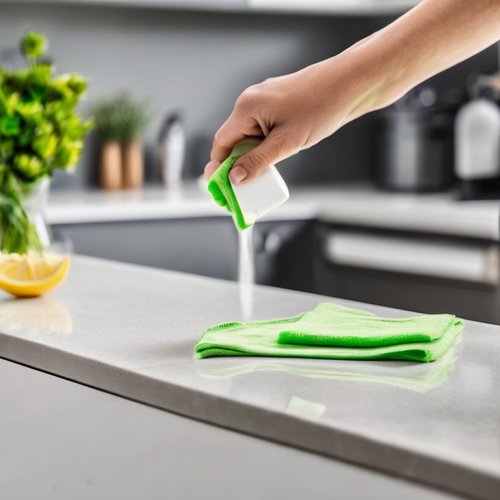The Clean Green: Insights from Leaders in Eco-Friendly Cleaning
In an age where the concept of sustainability is not merely a trend but a necessity, the cleaning industry finds itself at a crossroads, grappling with the pressing need to innovate. Enter eco-friendly cleaning: a philosophy that champions the health of our planet alongside the cleanliness of our homes. But what does it truly mean to clean green? To explore this vibrant intersection of cleanliness and environmental stewardship, we spoke with several leaders and experts forging paths in sustainable cleaning.
Redefining Cleanliness: A Paradigm Shift
Historically, cleaning has often been associated with the potency of harsh chemicals—think of bleach, ammonium hydroxide, and sulfates—as if invincible cleanliness could only sprout from toxic origins. But as if to echo Mother Nature herself, from the shadows emerged a new ethical framework. According to Maria Jensen, founder of Clean Green Solutions, “Eco-friendly cleaning is more than just a fad; it’s about creating a better world for future generations.” 🌎
Ironically, while we’ve cleansed our windows and floors with an arsenal of toxins, we seemingly overlooked the delicate fabric of our environment. The irony? The gleaming sheen of artificial cleanliness often came at the expense of our planet’s health—transforming our homes into sanctuaries of synthetic degrees of ‘clean’ that harbored hidden hazards.
Meeting Experts: An Essential Dialogue
As we converse with industry titans, we encounter the striking antithesis of eco-friendly approaches versus traditional methods. The adoption of sustainably sourced products and greener practices that challenge age-old cleaning paradigms reflects a progressive step toward environmental custodianship. Take, for instance, James Rivera, a veteran cleaning service operator whose embrace of green technologies has shifted his business model dramatically.
“It’s not just about what we clean with; it’s about how we interact with our clients and communities. The earth deserves better, and we have a duty to advocate for it,” he emphasizes while gesturing towards a panel of organic cleaning products lining the shelves of his storefront.
Understanding Eco-Friendly Products
Rip away the layers of marketing jargon, and what constitutes eco-friendly cleaning products? It’s often simpler than one might think, like a breath of fresh air wafting through an open window.
- Natural Ingredients: Many eco-conscious brands focus on plant-based ingredients, derived from sources that won’t cry out in despair when washed down the drain.
- Biodegradable Packaging: Sustainable products often come in packaging that doesn’t linger on landfills like regret at the end of a meal forgotten.
- Transparency: Who wants to play hide-and-seek with ingredients? Eco-friendly brands pride themselves on honesty, ensuring consumers are aware of what they bring into their homes.
- Energy Efficiency: Many green cleaning processes employ equipment designed to use less energy while being effective—like cleaning with the quiet efficiency of a serene mountain stream.
Conversations with Clients: Education as Empowerment
The pathway to transforming traditional cleaning practices relies heavily on educating clients—what good is a green service if the customer doesn’t appreciate its value? “We must encourage our clients to think critically about their choices,” remarks Emily Chen, an eco-consultant with an impressive clientele of eco-aware enthusiasts. 💡
Adopting green cleaning practices isn’t merely about swapping out brands; it’s about cultivating a mindset. Emily articulates the significance of choice, enhancing awareness around how small shifts can produce rippling effects, replicating the gentle expansion of a blossom opening to sunlight.
A Sustainable Cleaning Future: The Path Ahead
As we engage in these pivotal discussions, the future appears filled with potential. There’s no question that eco-friendly cleaning is more than a temporary solution—it’s the grassroots movement morphing this industry. The delightful irony remains that we are not only improving our cleaning practices but evolving towards a more sustainable future, with accountability ingrained in the process.
However, change requires collaboration among suppliers, companies, and consumers, as well as a dedication to continued advancement. What if, in the not-so-distant future, cleaning services recognized their ecological impact as they would any business metric? If numbers signify growth, might eco-friendly practices be the growth everyone’s been waiting for—a growth rooted in responsibility?
Final Thoughts: A Call to Action
The eco-friendly cleaning movement calls not just for action but for a cultural shift in how we perceive cleanliness and maintaining our homes. Ecosystems thrive on balanced interactions, and as cleaning service providers adopt eco-friendly practices, so too can our homes become healthier, more vibrant spaces. After all, cleaning should make us feel lighter, not heavier with the weight of remorse for what we leave behind.
In the end, it’s about transforming everyday tasks into meaningful actions. Who knew that scrubbing floors could also scrub our conscience clean? So here’s the dilemma for those in the cleaning game: Are you willing to trade in your traditional cleaning formula for one that promises sustainability and health—turning the act of cleaning into an act of love for both home and planet? 🌱✨
